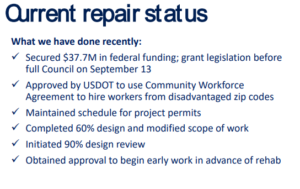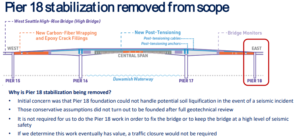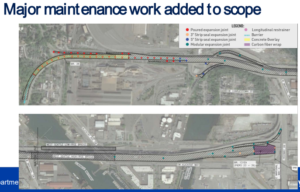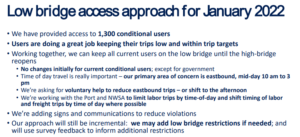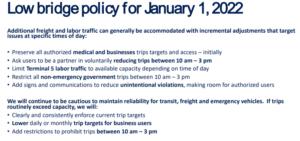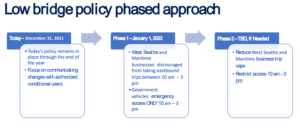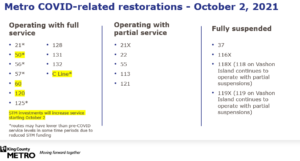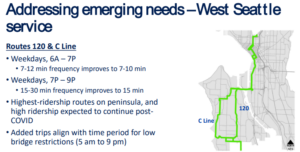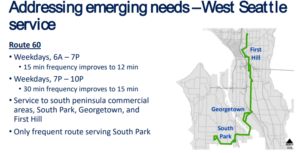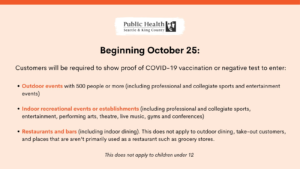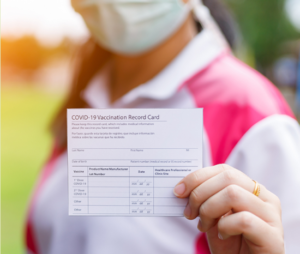West Seattle Bridge Community Task Force Updates
The West Seattle Bridge Community Task Force met on September 15, and includes two key updates.
First of all, the bridge repair remains on schedule for mid-2022.
Secondly, the West Seattle Water taxi will maintain daytime operating hours during the winter, instead of going to the regular winter schedule on October 15th. Thanks to King County and SDOT for working together to make this happen, and to City voters for approving the Seattle Transit Measure last year to provide funding.
West Seattle Bridge Repair
Construction on the repair is scheduled to begin in November, with some construction activities beginning next month.
Permit approvals have been attained on schedule, which is critical, as permitting delay in by external governments is a key risk for schedules for large capital projects.
Next month, early work on construction will include building work platforms off-site (work platforms were visible during the stabilization done last year), coring through parts of the bridge to allow installation of the work platforms, and relocating utilities inside the box girders in order to make room for post-tensioning.
There is one scope change to the bridge repair project. Additional geotechnical review has determined that seismic stabilization of Pier 18 will not be needed at this time. If the work is needed in the future, it would not require a traffic closure. The cost estimate for this work was $12 million.
Instead, the project will shift these funds to $12 million of major maintenance work, including work on expansion joints, concrete overlay and carbon fiber wraps. This work would be needed in the future, and disrupt traffic in future years. So doing it now makes good sense. Also, doing this work now allows the City to keep federal grant funds, rather than having to return them.
Lower Bridge Access Update
When the West Seattle Bridge was closed, SDOT limited use of the Spokane Street (lower) bridge between 5 a.m. and 9 p.m. to emergency vehicles, transit, freight and urgent government uses.
In June, SDOT granted conditional access to restaurants and retail businesses, maritime and industrial businesses, vanpools, employer shuttles, on-call medical workers, people traveling for lifesaving medical treatments, longshoreman, and urgent/unplanned trips for government vehicles (limited to urgent/unplanned trips and includes City of Seattle, King County, State of Washington, local law enforcement). Over 1,300 users have been granted access.
The bridge has been open for general use from 9 p.m. to 5 a.m.; in June SDOT added 5 a.m. to 8 a.m. for general use on Saturday and Sunday.
With Terminal 5 opening in January 2022, SDOT had announced that conditional uses granted to June would need to be revoked, or sharply restricted at that time, and use limited to emergency vehicles, transit and freight.
There is good news on this front. SDOT has announced they have no changes in the current access planned for January 2022, expect for additional limits on government vehicle use. This is possible, in large part, because users granted access have been judicious in their use of the bridge. The West Seattle Junction Business Association and the West Seattle Chamber, and representatives of other user groups have played a very helpful role in this, so I want to thank them for their efforts.
Based on current trip levels, and expected increase in freight traffic, SDOT is encouraging users to voluntarily reduce trips levels between 10 a.m. and 3 p.m. Their area of concern is especially regarding eastbound trips at that time; they are working with the Port and Northwest Seaport Alliance to shift trips when possible.
Here’s the current policy scheduled to take effect on January 1:
Below is a timeline for current access, and “Phase 1” access beginning on January 1. If there is a need to reduce access levels, a “Phase 2” plan would involve reducing West Seattle and maritime business trips caps (I.e. allowing fewer trips per month), and restricting access between 10 a.m. and 3 p.m.
West Seattle Transit Service
The Water Taxi’s summer sailing schedule was set to end on October 15, which would normally mean an end to mid-day and weekend sailings until next spring. However, this year SDOT will provide the funding needed to maintain full daytime service from 6 a.m. to 7 p.m. all winter long as repairs continue to the West Seattle High-Rise Bridge. This funding comes from the Seattle Transit Measure approved by voters last year, which allowed for use by the water taxi, a subject we discussed at the Council before voting to place the measure on the ballot.
The West Seattle Bridge closure has been incredibly hard on all of us. I’ve heard from constituents, who rely on the Water Taxi, how important regular and frequent service is. Maintaining summer-level daytime Water Taxi service through the winter will maintain an important option to get on and off the peninsula.
Here’s the schedule for the fall and winter:
- Seven day a week service between Seacrest Park in West Seattle and Pier 50 downtown from approximately 6:00 a.m. to 7:00 p.m.
- Ships will leave the dock every 35 minutes during weekday peak commute hours and every hour mid-day, evenings, and weekends.
- The expanded service will not include late night Friday and Saturday sailings after 7:00 p.m.
Other improvements for bus service are scheduled to take effect October 2, and will provide more frequent service on Routes 50, 60, 120 and RapidRide C Line during the bridge closure, and for some of the time afterwards (it is scheduled to be phased out in fall 2022 and spring 2023).
The transit ballot measure Included a spending category to address “emerging mobility needs” such as the long-term closure of the West Seattle Bridge. I proposed an increase in the amount of funds allowed for this category, which the Council adopted.
Here’s updated service for District 1 bus routes starting October 2:
Below are the details for increased service while the bridge is closed:
C Line and 120:
| Route 50 (though it now goes on Lander St overpass), so the map for the SODO portion is out of date; it also continues on to Othello station: |
| Route 60, starts by Westwood Village, and goes to Broadway on Capitol Hill and medical and employment centers on First Hill: |
Terminal 5 Quiet Zone
On Monday the Council unanimously approved Council Bill 120138, authorizing the Seattle Department of Transportation (SDOT) to acquire property needed to construct the necessary improvements for a quiet zone.
Inn 2016, prior to T-5 shutting down, I received many emails about noise from trains leaving T-5 at the Chelan Café intersection and suggesting designation of the area as a “quiet zone.” See here for more about quiet zones. This led to the development of a Statement of Legislative Intent (SLI) in 2016, during my first year in office. SLI 66-1-A-1, in 2016, requested SDOT work with the Port of Seattle, the Federal Railway Administration, and the railway companies doing business at T-5, to extend the quiet zone along W Marginal Way between Delridge Way SW and 17th Ave SW.
T-5 has been undergoing an modernization project which is nearly complete and the Port expects full rail operations beginning in 2022. The timeline originally slated the quiet zone to be completed in December 2020, but the project has been plagued with delays. Fortunately SDOT is now able to move forward with property acquisition and we’re hopeful that construction will begin in 2022 and a quiet zone will be established by 2023.
Proof of Vaccination in Public Places
Seattle residents have led the nation in fighting the pandemic. We’ve stayed socially distant, moved our socializing outside, masked up, and gotten vaccinated to keep our neighbors and loved ones safe and healthy.
Yesterday, I joined King County Health Officer Dr. Jeffrey Duchin, along with King COunty Executive Constantine and Mayor Durkan and industry leaders, as he announced an additional layer of protection from COVID-19. The new Verification of Vaccination Health Order will require people attending recreational activities in most public places to show proof that they have been vaccinated against COVID-19, starting October 25th.
An analysis by the University of Washington’s Institute for Health Metrics and Evaluation (IHME) found that the vaccine verification policy at restaurants, bars, and gyms/fitness centers alone could have a significant positive impact, preventing between 17,900 and 75,900 infections, 421 and 1,760 hospitalizations, and 63 and 257 deaths locally over six months with the order in place.
This Order will make it possible for our small business owners, cultural workers, and hourly workers to get back to work while keeping our community safe. I’m more than ready to return safely to live music and meals out with friends and family. As Chair of the committee with oversight of Public Health, I deeply appreciate the industry leaders who have worked so tirelessly with Public Health to craft this policy.
What can be used as proof of vaccination?
- CDC vaccination card or photo of vaccine card.
- Documented proof of vaccination from medical record or vaccine provider.
- Printed certificate or QR code (available at the end of September) from com.
You do not need to show identification with proof of vaccination.
Not yet vaxed? It’s much easier to get vaccinated now than it was earlier this year – and it’s free!
- Enter your zip code to find convenient vaccine shots at Vaccinate WA.
- For in-language assistance scheduling a vaccination, call one of the Vaccine Community Helplines.
- Check out this map, which shows District 1 vaccine providers
- Look for vaccine popup clinics near you.
Have more questions? Public Health’s webpage has a detailed Frequently Asked Questions section. You can also read this Public Health Insider blog post and view the Local Health Order.
SDOT Survey on the Alki Point
The Seattle Department of Transportation has released a survey to gather input on the future of the Alki Point Keep It Moving Street. The majority of people contacting me about the Alki Point Keep Moving Street have reported that it provides many benefits including improved safety, accessibility, sustainability, mobility and livability.
On Page 5 of the SDOT survey presents three design options:
- Option 1: Stay Healthy Street + Neighborhood Greenway
- Option 2: Neighborhood Greenway + additional pedestrian space
- Option 3: One-way street with shared walking and biking path
- Option 1 is the option to make permanent a Stay Healthy Street.
Options 2 and 3 allow cars back onto the street. For that reason, supporters of keeping cars off the street recommend option 1,
To take the survey please click here.
The comments section will allow you to describe any additional changes or improvements you would like to see.
SPD Supplemental Budget Vote
The Council voted on Monday to adopt a mid-year supplemental budget ordinance. It includes spending authorization regarding the SPD budget. Approximately $15 million of SPD’s adopted budget is estimated to not be needed to fund officer salaries as approved by the Council last Fall in the fully-funded 2021 hiring plan, due to continued larger than projected by SPD number of officers leaving. So the question for the Council was how to spend these funds for 2021 priorities.
The legislation includes amendments adopted by the Finance and Housing Committee that Councilmember Mosqueda and I co-sponsored, and additional amendments I sponsored, to address the shortage of police officers. Again, as mentioned above, the 2021 officer hiring budget has always been fully funded.
SPD thanked the Council for the vote, which included funding for community service officers, crime prevention coordinators, mental health/wellness, hiring process accelerators, continued 911 call analysis to support re-imagining policing, and technology for updating and modernizing SPD’s management of overtime, and funding for overtime, with more public events taking place than anticipated in the 2021 budget.
It also includes funding for the Triage One program, Regional Peacekeepers Collective, items with strong joint support from the Council, Mayor and SPD.
The funding package also includes $3 million for Community Safety Investments. HSD recently approved $10.4 million for 33 proposals, out of 73 submitted. HSD approved $10.4 million of the $17.8 million requested, so there are ready-to-go community safety proposals that could be funded with additional funds..
The legislation also releases spending restrictions on $7.5 million in funds that were retained within SPD’s budget, but listed for possible use in a 2021 participatory budgeting program; that program isn’t proceeding during 2021.
In July, I requested SPD present the Council with spending options to ameliorate the staffing shortage, and I appreciate their sending recommendations, most of which the Council funded.
After several meetings in the Finance and Housing Committee, and additional discussion in the Public Safety and Human Services Committee, there was an amendment at Full Council regarding recruitment and retention of police officers.
Hiring and retention is an important issue, that’s why the amendments I co sponsored included investments to support these efforts, such as adding $320,000 for technology upgrades for officer wellness and supervision that support retention, and $110,000 in funding for a third-party backgrounding service, to accelerate the hiring process for both sworn and civilian positions and support recruitment. Some potential hires pursue new employment opportunities due to the length of the hiring process and necessary background checks, so this change is needed.
I believe the topic merits additional attention through the annual budget process, which begins on September 27th. Central Staff has determined that the Executive has documented staffing shortages and accompanying service delivery issues in several departments.
The impacts of COVID on employment has been unprecedented, both for the private sector as well as the public sector with people leaving their jobs and with sustained vacancies across most employment sectors. I value the delivery of city services of all city departments and if we need to discuss recruitment bonuses, I think we need to consider vacancies across all city departments and whether we need to consider hiring bonuses to fulfill hiring goals and service delivery obligations for other departments as well.
For example, the Fire Department also has staffing challenges that merit close attention.
I want to analyze this issue across city departments in a comprehensive way; the proposal from Councilmember Pederson would have authorized SPD to pay up to $15,000 per hire; if we are considering hiring bonuses for hires to other departments, we need to consider the possible citywide cost. Consequently I voted against the proposal. There are practical issues with the two versions of the amendment as well, which would provide funding for the remainder of 2021 only.
Of the two versions of the amendment, one included $230,000 for hiring bonuses, but despite the description of the amendment, the rest of the $3 million for officer retention didn’t have a clearly specified use, and would likely need to be re-authorized during the 2022 budget process. The other version of the amendment proposed using as a funding source $1 million in discretionary funding for SPD. With more public events taking place than anticipated in the 2021 budget, as well as staffing shortages, I prefer this funding remain available to SPD as discretionary use as needed.
I also strongly support what the 2019 Hiring and Retention report from August 2019 called “Wellness-First Schedules” of 4 10 hour shifts to provide 3 consecutive days of rest for officers, rather than only 2 days of rest. This has long been a priority of SPD officers and would help greatly to address both recruitment and retention.
Many front line city workers have receive “appreciation pay” for their service during the pandemic. Appreciation pay is one officer retention strategy and I am supportive of continued discussions for how to best authorize appreciation pay for police officers. I am very grateful for the officers who have not left SPD and remain committed to community safety and committed, specifically, to Seattle.
Proclamation honoring those who responded to domestic violence
On Monday the Council and Mayor signed a proclamation honoring those who responded to a domestic violence homicide.
The Domestic Violence Unit of the King County Prosecutor’s Office wrote a letter to the Council and Mayor in requesting recognition from the City of Seattle. I welcomed the opportunity to offer this recognition to Seattle residents, police and fire department personnel, and Seattle Center employees – who responded with heroism, professionalism, and empathy to try and save a life, address the trauma of a child, and hold the offender accountable for what is described as “among the most public and graphic domestic violence homicides in Seattle and Washington state history.”
Duwamish Superfund Site
Monday marked the 20th anniversary since the Duwamish River was declared a superfund site. Unfortunately the Environmental Protection Agency (EPA) has released a proposal that could lower the amount and effectiveness of the clean-up efforts. There is disagreement about the methodology of the EPA’s recent study. Unfortunately, instead of moving forward with the original requirements or verifying their study results with additional academic input, they are forging ahead.
During a public comment period earlier this year I implored the EPA to conduct additional testing as requested by the Duwamish River Clean Up Coalition; however that has not happened. The EPA continues to move forward; though they are collecting additional public comment, which you can submit via email here. Comments must be sent in by September 27.
I would encourage you to read the Seattle Times Op-Ed by Paulina López, James Rasmussen, and BJ Cummings.
Virtual Office Hours
On Friday September 24, I will be hosting virtual office hours between 2pm and 6pm, with the last meeting of the day beginning at 5:30pm.
Due to the nature of virtual office hours, please contact my scheduler Alex Clardy (alex.clardy@seattle.gov) in order to receive the call-in information and schedule a time.
Additionally, here is a list of my tentatively scheduled office hours which will continue as virtual office hours until indicated otherwise. These are subject to change.
- Friday, October 29, 2021
- Friday, December 17, 2021


